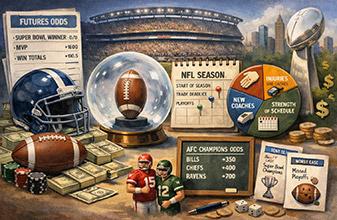Competing against multiple tournament tables

Casino games tournaments are fun, and they can be profitable too. In upcoming articles, we will continue to publish a series of excerpts from Stanford Wong’s book, Casino Tournament Strategy.
This article applies to the situation where you are competing against more than just the players at your table; you are trying to finish with a higher bankroll than players at a number of tables. The strategies are valid for land-based casinos in Las Vegas or elsewhere, as well as online tournaments.
The strategy is to pick out a goal bankroll size that will win. Then go all out for that number or zero. Either bust out or hit your goal.
Succeed or Bust
A large part of your edge comes from applying a simple money-management strategy: Either advance to the next round or bust out.
The succeed-or-bust strategy is easiest to understand in tournaments where you know what bankroll total will allow you to advance to the next round. For example, at one tournament contestants buy in with $500 and know for certain that finishing with $1000 or more will put them in the second round. You maximize your chance of advancing to the second round by maximizing your chance of turning your initial $500 into $1000.
Your average ending bankroll is about the same no matter how you bet your money, and is equal to your beginning bankroll less the casino edge on the bets you make. It also is equal to your probability of finishing with more than $1000 times the average bankroll you end up with if you finish with more than $1000, plus your probability of finishing with less than $1000 times the average bankroll you end up with if you finish with less than $1000.
Maximizing your probability of finishing with more than $1000 means stopping as close to $1000 as you can when you make it, and going bust if you do not finish with at least $1000. If you do that, you have almost a 50% chance of turning your initial $500 into $1000 or more.
Setting Your Goal
There seems to be a simple square-root relationship between the proportion of contestants moving on to the next round and the bankroll required to be one of those lucky ones. For example, if one fourth of the contestants are going to advance from round 1 to round 2 of the tournament, a good estimate of the bankroll required is double the starting bankroll. The ratio of entrants to number moving on is 4, and the square root of 4 is 2. When playing in such a tournament, try to double your starting bankroll or bust out.
This relationship holds best for large numbers of contestants advancing to the next round; when twenty or fewer contestants advance, the square-root relationship breaks down.
By being among the last to register for the tournament, you probably can get in the final playing session. This allows you to monitor the earlier sessions to set a better target.
As more and more players learn to go for bust or advance to the next round, the cutoff score will be higher.
Probability of Attaining Your Goal
A good approximation of your probability of achieving any particular target bankroll is the ratio of your present bankroll to your target. Think of it as conservation of expected value. Suppose you need to triple your present bankroll. What is your probability of doing it?
Answer: approximately 1/3.
Suppose you need to multiply your present bankroll by ten.
What is your probability of doing it? Answer: approximately 1/10.
Attaining Your Goal
Try to avoid getting stuck with chips you cannot bet. If you cannot bet a $2.50 chip and the minimum bet is $10, avoid making a bet of $15 or any other odd number unless you are going all in. When the minimum bet is $5 and you cannot bet a $2.50 chip, bet $5 anyway and do not worry if you get a chip you cannot bet.
This article is part of a series, to be continued…
Excerpted with permission from Casino Tournament Strategy by Stanford Wong, edited for this format.











Please log in or register to leave a comment